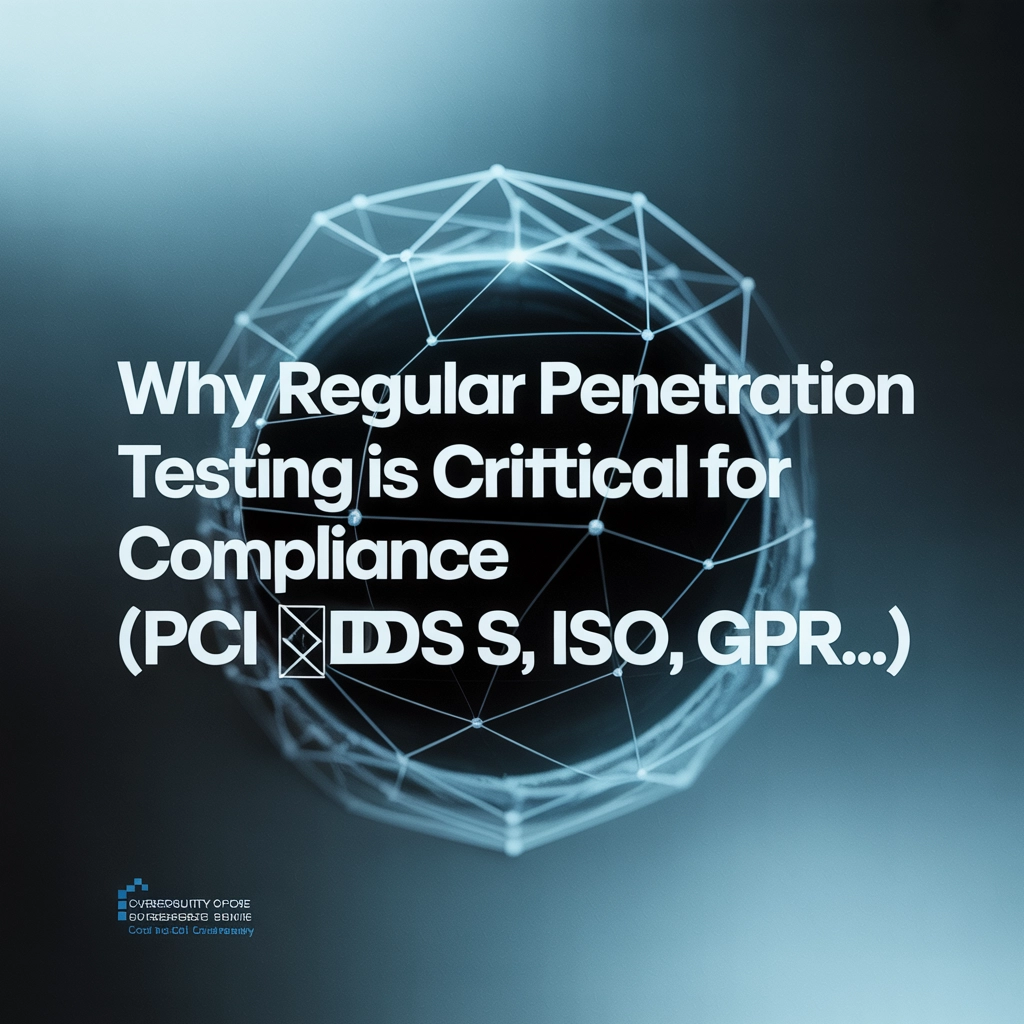In today’s complex regulatory landscape, organisations face mounting pressure to demonstrate robust security practices. Penetration testing has evolved from a nice-to-have security measure to an essential component of compliance frameworks worldwide. But why exactly has penetration testing become so critical for meeting regulatory requirements? Let’s dive into why regular penetration testing isn’t just good security practice, it’s becoming non-negotiable for compliance.
The Evolving Compliance Landscape
The regulatory world has shifted dramatically in recent years. Where vague security guidelines once sufficed, detailed technical requirements now dominate compliance frameworks. Modern standards like PCI DSS, ISO 27001, and GDPR demand concrete evidence that security controls are not only in place but actually effective against real-world attacks.
This shift reflects a fundamental truth: compliance isn’t just about ticking boxes anymore. Regulators want evidence that you’re actively protecting sensitive data against sophisticated threats. As breach costs continue to rise, averaging £3.2 million per incident in the UK, the stakes for non-compliance have never been higher.
Penetration Testing Requirements Across Major Frameworks
Different compliance frameworks approach penetration testing with varying degrees of specificity:
PCI DSS: Explicit Requirements
The Payment Card Industry Data Security Standard (PCI DSS) leaves no room for interpretation. Requirement 11.4 explicitly mandates penetration testing at least annually and after any significant infrastructure or application changes. This requirement applies to all organisations handling credit card data, regardless of transaction volume.
PCI DSS 4.0 has strengthened these requirements further, specifically mandating:
- External AND internal penetration testing
- Testing of both application and network layers
- Testing methodology based on industry-accepted approaches
- Testing performed by qualified personnel
Failure to conduct these tests can result in direct non-compliance, potentially leading to hefty fines and the loss of card processing privileges.
ISO 27001: Implicit But Essential
While ISO 27001 doesn’t explicitly name penetration testing, it’s nearly impossible to satisfy certain controls without it. Annex A.12.6 requires “technical vulnerability management,” which must include “evaluation of potential technical vulnerabilities” and appropriate measures to address identified risks.
For ISO 27001 certification, auditors typically expect to see evidence of regular security testing, with penetration testing being the gold standard for demonstrating control effectiveness.
GDPR: Risk-Based Approach
The General Data Protection Regulation takes a principles-based approach to security. Article 32 requires “a process for regularly testing, assessing and evaluating the effectiveness of technical and organisational measures for ensuring the security of processing.”
While GDPR doesn’t specify penetration testing by name, it has become the de facto method for demonstrating compliance with this requirement, especially for organisations processing large volumes of personal data.

Beyond Checkbox Compliance: The Strategic Value
Penetration testing delivers far more than mere compliance, it provides strategic value that supports regulatory objectives:
1. Evidence-Based Risk Assessment
Modern compliance frameworks are increasingly risk-based, requiring organisations to identify and prioritise security vulnerabilities. Penetration testing provides concrete evidence of actual exploitable vulnerabilities, allowing for evidence-based risk prioritisation that satisfies auditors.
As one CISO noted in a recent survey, “Penetration testing transformed our compliance approach from theoretical to practical. We now have hard data to show auditors instead of just process documents.”
2. Validation of Security Controls
Nearly every compliance framework requires validation that security controls are functioning as intended. Penetration testing provides this validation by attempting to bypass security controls in real-world scenarios.
This is particularly critical for frameworks like HIPAA, which requires comprehensive safeguards for protected health information but doesn’t prescribe specific technical controls. Penetration testing demonstrates that whatever controls you’ve chosen are actually effective.
3. Documentation of Due Diligence
In the event of a security incident, regulators will examine whether your organisation took reasonable steps to prevent the breach. Regular penetration testing provides clear documentation of your security due diligence.
For frameworks like GDPR, which can impose fines of up to 4% of annual global turnover, this documentation can be the difference between being seen as negligent versus having a strong security programme that experienced an unfortunate incident.
Compliance-Specific Benefits of Penetration Testing
Different compliance standards benefit from penetration testing in specific ways:
For PCI DSS Compliance
Penetration testing identifies vulnerabilities in cardholder data environments that automated scans might miss, such as:
- Business logic flaws in payment applications
- Complex authentication bypass techniques
- Chained vulnerabilities that only human testers can identify
- Encryption implementation weaknesses
A properly scoped PCI penetration test validates segmentation controls, ensuring that cardholder data environments are properly isolated from less secure networks, a key requirement for scope reduction.
For ISO 27001 Certification
ISO auditors look for evidence that your Information Security Management System (ISMS) is effective. Penetration testing provides:
- Objective evidence of control effectiveness
- Validation of risk treatment plans
- Inputs for continual improvement
- Demonstration of security monitoring capabilities
Many organisations find that penetration testing helps satisfy multiple ISO controls simultaneously, streamlining the certification process.

For GDPR Compliance
Data protection authorities increasingly expect to see technical testing as part of GDPR compliance. Penetration testing helps by:
- Validating that personal data is properly secured
- Testing data access controls and authentication mechanisms
- Identifying potential data leakage paths
- Verifying that data minimisation principles are implemented technically
Timing and Frequency Considerations
Compliance isn’t a one-time achievement, it’s an ongoing process. Most frameworks require penetration testing:
- At least annually (explicit in PCI DSS)
- After significant changes to infrastructure or applications
- When new threats emerge that could impact your security posture
- Before major compliance audits or certifications
For many organisations, alternating between different testing scopes throughout the year provides the most comprehensive coverage while spreading costs over the financial year.
Best Practices for Compliance-Focused Penetration Testing
To maximise the compliance value of your penetration testing programme:
- Align test scopes with compliance boundaries
Ensure your penetration testing scope explicitly covers all systems within scope for your compliance requirements. - Maintain clear documentation chains
Create direct links between penetration test findings, remediation activities, and compliance requirements to demonstrate due diligence. - Engage qualified testers
Some frameworks (notably PCI DSS) require testing by qualified individuals with specific certifications or credentials. - Develop robust remediation processes
Compliance frameworks increasingly require evidence that identified vulnerabilities are remediated in a timely manner. - Test beyond compliance minimums
The most effective compliance programmes use penetration testing to go beyond minimum requirements, testing additional systems and using advanced methodologies.

From Compliance Requirement to Security Advantage
While penetration testing may begin as a compliance requirement, forward-thinking organisations transform it into a competitive advantage. By using penetration testing to drive continuous security improvement, these organisations create security programmes that easily satisfy compliance requirements while providing genuine protection against evolving threats.
Regular penetration testing provides the evidence needed to demonstrate compliance while simultaneously strengthening your actual security posture, turning a regulatory requirement into a business advantage.
At EJN Labs, we specialise in helping organisations navigate the complex intersection of penetration testing and compliance requirements. Our testing methodologies are specifically designed to satisfy multiple regulatory frameworks simultaneously, maximising the compliance value of every test.
To learn more about how penetration testing can support your compliance objectives, visit our penetration testing fundamentals page or contact our compliance specialists for a personalised consultation.











Leave a Reply